Shulgi
| Shulgi 𒀭𒂄𒄀 | |
|---|---|
  | |
| King of the Neo-Sumerian Empire | |
| Reign | c. 2094 BC – 2046 BC |
| Predecessor | Ur-Nammu |
| Successor | Amar-Sin |
| Issue | Amar-Sin, Liwir-Mitashu |
| Dynasty | 3rd Dynasty of Ur |
| Father | Ur-Nammu |
| Mother | Watartum |
(c. 2094–2046 BC)
nin-a-ni..................... "his Lady,"
šul-gi.................... "Shulgi"
nitah kalag-ga...... "the mighty man"
lugal........................"King"
urimki-ma............... "of Ur"
lugal ki-en-............... "King of Sumer"
gi ki-uri-ke4................. "and Akkad,"
e2-a-ni.......................... "her Temple"
mu-na-du3................... "he built"
Shulgi (𒀭𒂄𒄀 dšul-gi, formerly read as Dungi) of Ur was the second king of the Third Dynasty of Ur. He reigned for 48 years, from c. 2094 – c. 2046 BC (Middle Chronology).[4] His accomplishments include the completion of construction of the Great Ziggurat of Ur, begun by his father Ur-Nammu. On his inscriptions, he took the titles "King of Ur", "King of Sumer and Akkad", adding "King of the four corners of the universe" in the second half of his reign.[5] He used the symbol for divinity (𒀭) before his name, marking his apotheosis, from at least the 21st year of his reign and was worshipped in the Ekhursag palace he built.[6] Shulgi was the son of Ur-Nammu king of Ur and his queen consort Watartum.[7]
Life and reign
[edit]Shulgi apparently led a major modernization of the Third Dynasty of Ur. He improved communications, reorganized the army, reformed the writing system and weight and measures, unified the tax system, and created a strong bureaucracy.[8] He also wrote a law code, now known as the Code of Ur-Nammu because it was originally thought to have been authored by Ur-Nammu.[4] He also built or rebuilt numerous temples throughout the empire.[9]
Shulgi is best known for his extensive revision of the scribal school's curriculum. Although it is unclear how much he actually wrote, there are numerous praise poems written by and directed towards this ruler. He had proclaimed himself a god by his 21st regnal year (there are indications this occurred as early as S12), and was recognized as such by the whole of Sumer and Akkad.[4][10]
Some much later chronicles castigate Shulgi for his impiety: The Weidner Chronicle (ABC 19), a literary composition written in the 1st millennium BC, states that "he did not perform his rites to the letter, he defiled his purification rituals".[11] CM 48, written late in the 1st millennium BC, charges him with improper tampering with the rites, composing "untruthful stelae, insolent writings" on them.[11] The Chronicle of Early Kings (ABC 20), written in the mid-2nd millennium BC, accuses him of "criminal tendencies, and the property of Esagila and Babylon he took away as booty."[11]
The manner of death is unknown, only that it occurred in his 48th regnal year, in or before the 11th month. In the 3rd month of his successor, libations to the dead were first recorded for Shulgi and two wives Geme-Ninlila and Shulgi-simti. All three appear to have died in the year 48. Several researchers have suggest Shulgi was assassinated, partly based on omen texts, including one based on an eclipse.[12][13][14] He was succeeded by Amar-Sin. The name Amar-Sin was not recorded before his ascension and is a "throne name". His original name, and whether he was actually the son of Shugi, is unknown.[15]
Name
[edit]Early uncertainties about the reading of cuneiform led to the readings "Shulgi" and "Dungi" being common transliterations before the end of the 19th century. However, over the course of the 20th century, the scholarly consensus gravitated away from dun towards shul as the correct pronunciation of the 𒂄 sign. The spelling of Shulgi's name by scribes with the diĝir determinative reflects his deification during his reign, a status and spelling previously claimed by his Akkadian Empire predecessor Naram-Sin.[16]
-
Portraits of Shulgi from his Nuska seal. Louvre Museum
-
Portrait of Shulgi as a builder, on a foundation nail. Metropolitan Museum of Art
Marriages
[edit]Shulgi was a contemporary of the Shakkanakku rulers of Mari, particularly Apil-kin and Iddi-ilum.[17] An inscription mentions that Taram-Uram, the daughter of Apil-kin, became the "daughter-in-law" of Ur-Nammu, and therefore the Queen of king Shulgi.[18][19] In the inscription, she called herself "daughter-in-law of Ur-Nammu", and "daughter of Apil-kin, Lugal ("King") of Mari", suggesting for Apil-kin a position as a supreme ruler, and pointing to a marital alliance between Mari and Ur.[20][21]
Nin-kalla, Amat-Sin, and Ea-niša were queens of Shulgi. This had influence and performed official functions which continued even after the death of Shulgi.[22][23] Another queen, Shulgi-simti, who is known from a high number of texts presenting evidence for her economic power, had similar status. The archive shows she selected various large animals to use in rituals for deities including Belet-Šuḫnir and Belet-Terraban, Annunitum, Ulmašītum, Nanna, Ninlil and Enlil.[24] From thirty-second to forty-seventh year of Shulgi's reign she was in charge of the acceptance of ritual animals. On their death "libation places" for her and Shulgi were established.[7][25] Another important woman was Geme-Ninlilla who appears in texts at the end of the king's reign. Other, less well known royal women are Šuqurtum, Simat-Ea and Geme-Su'ena.[26]
Shulgi, with many wives and concubines, is known to have had at least sixteen sons including Etel-pū-Dagān, Amar-dDa-mu, Lu-dNanna, Lugal-a-zi-da, Ur-d,Suen, and possibly Amar-Sin (his throne name) as well as one daughter, Peš-tur-tur.[27][28][29] The name of another daughter, Šāt-Kukuti, is known from a cuneiform tablet.[30] A daughter, Taram-Šulgi was married to the ruler of Pašime, Šudda-bani.[18]
Royal hymns
[edit]
Shulgi also boasted about his ability to maintain high speeds while running long distances. He claimed in his 7th regnal year to have run from Nippur to Ur, a distance of not less than 100 miles.[31] Kramer refers to Shulgi as "The first long distance running champion."[32]
Shulgi wrote 26 royal hymns to glorify himself and his actions. In one Shulgi claimed that he spoke Elamite as well as he spoke Sumerian.[33][34] In another he refers to himself as "the king of the four-quarters, the pastor of the black-headed people".[35]
Armed conflicts
[edit]While Der had been one of the cities whose temple affairs Shulgi had directed in the first part of his reign, in his 20th year he claimed that the gods had decided that it now be destroyed, apparently as some punishment. The inscriptions state that he "put its field accounts in order" with the pick-axe. His 18th year-name was Year Liwir-mitashu, the king's daughter, was elevated to the ladyship in Marhashi, referring to a country near Anshan and her dynastic marriage to its king, Libanukshabash.[36] Following this, Shulgi engaged in a period of expansionism at the expense of highlanders such as the Lullubi, and destroyed Simurrum (another mountain tribe) and Lulubum nine times between the 26th and 45th years of his reign.[37] He is also known to have destroyed Karaḫar, Harši, Šašrum, and Urbilum.[38] In his 30th year, his daughter was married to the governor of Anshan; in his 34th year, he was already levying a punitive campaign against the place. He also destroyed Kimaš and Ḫurti (cities to the east of Ur, somewhere near Elam) in the 45th year of his reign.[39][40] An inscribed brick recorded:
"Sulgi, god of his land the mighty, king of Ur, king of the four quarters, when he destroyed the land of Kimas and Hurtum, set out a moat and heaped up a pile of corpses."[9]
As with many Mesopotamian rulers he dealt with nomadic incursion in his 37th year, he was obliged to build a large wall in an attempt to keep out the Tidnumite nomads.[9]
Susa
[edit](c. 2094–2047 BCE)
nin-a-ni....................... "his Lady,"
dšul-gi.................... "Shulgi"
nitah kalag-ga........ "the mighty man"
lugal urimki-ma..... "King of Ur"
lugal ki-en-................. "King of Sumer"
gi ki-uri-ke4..................... "and Akkad,"
nam-ti-la-ni-še3........... "for his life"
a mu-na-ru................... "dedicated (this)"
Shulgi is known to have made dedications at Susa, as foundation nails with his name, dedicated to god Inshushinak have been found there. One of the votive foundation nails reads: "The god 'Lord of Susa,' his king, Shulgi, the mighty male, king of Ur, king of Sumer and Akkad, the..., his beloved temple, built.".[44][16] An etched carnelian bead, now located in the Louvre Museum (Sb 6627) and inscribed with a dedication by Shulgi was also found in Susa, the inscription reading: "Ningal, his mother, Shulgi, god of his land, King of Ur, King of the four world quarters, for his life dedicated (this)".[16][45]
The Ur III dynasty had held control over Susa since the demise of Puzur-Inshushinak, and they built numerous buildings and temples there. This control was continued by Shulgi as shown by his numerous dedications in the city-state.[46] He also engaged in marital alliances, by marrying his daughters to rulers of eastern territories, such as Anšan, Marhashi and Bashime.[46]
-
Votive tablet of Shulgi, excavated in Susa: "For the goddess Ninhursag of Susa, his Lady, Shulgi, the great man, King of Ur, King of Sumer and Akkad, built her temple ". Louvre Museum, Sb 2884.[47]
-
Carnelian bead with dedicatory inscription by Shulgi, found in Susa. Louvre Museum, Sb 6627
Year names
[edit]
There are extensive remains for the year names of Shulgi, which have been largely reconstructed from year 1 to year 48 though some are fragmentary. There are no contemporary lists of year names, only partial texts from the Old Babylonian period so the order is not completely certain and a few years attribution is uncertain between Ur-Nammu and Shulgi. There are also multiple year names for some years which is not unprecedented.[9] For example year 20 is "Year: “Ninḫursaga of Nutur was brought into her temple”" and "Year: “The sons of Ur were conscripted as lancers”".[49] Some of the most important are:
1. Year : Šulgi is king
2. Year: The foundations of the temple of Ningubalag were laid
6. Year: The king straightened out the Nippur road
7. Year: The king made a round trip between Ur and Nippur (in one day)
10. Year: The royal mountain-house (the palace) was built
18. Year: Liwirmittašu, the daughter of the king, was elevated to the queenship of Marhashi
21c. Year: Der was destroyed
24. Year: Karahar was destroyed
25. Year: Simurrum was destroyed
27. Year after: "Šulgi the strong man, the king of the four corners of the universe, destroyed Simurrum for the second time"
27b. Year: "Harszi was destroyed"
30. Year: The governor of Anšan took the king's daughter into marriage
31. Year: Karhar was destroyed for the second time
32. Year: Simurrum was destroyed for the third time
34. Year: Anshan was destroyed
37. Year: The wall of the land was built
42. Year: The king destroyed Šašrum
44. Year: Simurrum and Lullubum were destroyed for the ninth time
45. Year: Šulgi, the strong man, the king of Ur, the king of the four-quarters, smashed the heads of Urbilum, Simurrum, Lullubum and Karhar in a single campaign
46. Year: Šulgi, the strong man, the king of Ur, the king of the four-quarters, destroyed Kimaš, Hurti and their territories in a single day
Year name 39 of Shulgi was "The year Šulgi, king of Ur, king of the four quarters, built é-Puzriš-Dagan, a residence {palace? temple?} of Šulgi".[52]
Artifacts and inscriptions
[edit]-
Lugal Urimkima/ Lugal Kiengi Kiuri 𒈗𒋀𒀊𒆠𒈠𒈗𒆠𒂗𒄀𒆠𒌵, "King of Ur, King of Sumer and Akkad, on a votive tablet of Shulgi. The final ke4 𒆤 is the composite of -k (genitive case) and -e (ergative case).[53]
-
Shulgi completed the great Ziggurat of Ur
-
Earrings inscribed in the name of Shulgi.[54]
-
Seal of Shulgi, with worshipper and seated deity: "Shulgi, the mighty hero, King of Ur, king of the four regions, Ur-(Pasag?) the scribe, thy servant".[55]
-
Mace head in the name of Shulgi (inscription upside down). British Museum.
-
Duck-shaped official weight of 2 mina, reign of Shulgi, from Ur, Iraq. British Museum.
-
Weight of +1⁄2 mina (actual weight 248 gr.) dedicated by King Shulgi and bearing the emblem of the crescent moon: it was used in the temple of the Moon-God at Ur. Diorite, beginning of the 21st century BC (Ur III). Louvre Museum, Department of Oriental Antiquities, Richelieu, first floor, room 2, case 6
-
Tablet of Shulgi, glorifies the king and his victories on the Lullubi people and mentions the modern-city of Erbil and the modern-district of Sulaymaniyah, Sulaymaniyah Museum, Iraq
See also
[edit]- Correspondence of the Kings of Ur
- History of Sumer
- List of Mesopotamian dynasties
- Sumerian king list
- Self-praise of Shulgi
References
[edit]- ^ Full transcription: "CDLI-Archival View". cdli.ucla.edu.
- ^ Enderwitz, Susanne; Sauer, Rebecca (2015). Communication and Materiality: Written and Unwritten Communication in Pre-Modern Societies. Walter de Gruyter GmbH & Co KG. p. 28. ISBN 978-3-11-041300-7.
- ^ [1]Richard L. Zettler, "From Beneath The Temple Inscribed Objects From Ur", Expedition Magazine, University Museum of the University of Pennsylvania, vol. 28, no. 3, 1986
- ^ a b c [2]Klein, Jacob, "Shulgi of Ur: king of a Neo-Sumerian empire", Civilizations of the ancient Near East 2, pp. 843-857, 1995
- ^ [3]Suter, Claudia E., "A Shulgi statuette from Tello", Journal of Cuneiform Studies 43.1, pp. 63-70, 1991
- ^ Raphael Kutscher, "An Offering to the Statue of Šulgi", Journal of the Institute of Archaeology of Tel Aviv University, vol. 1, iss. 2, pp. 55-59, 1974
- ^ a b Sharlach, Tonia M., "Shulgi-simti and the Representation of Women in Historical Sources", Ancient Near Eastern Art in Context. Studies in Honor of Irene J. Winter by Her Students. Leiden & Boston, Brill, pp. 363-368, 2007
- ^ [4]Piotr Michalowski, "The Mortal Kings of Ur: A Short Century of Divine Rule in Ancient Mesopotamia", in Religion and Power: Divine Kingship in the Ancient World and Beyond Nicole Brisch, ed., Oriental Institute Seminars 4 Chicago: The Oriental Institute, 2008. Second printing with minor corrections, pp. 33-45, 2012 ISBN 978-1-885923-55-4
- ^ a b c d Frayne, Douglas, "Šulgi", Ur III Period (2112-2004 BC), Toronto: University of Toronto Press, pp. 91-234, 1997
- ^ Woolley, C. Leonard. The Sumerians. New York: W. W. Norton. pp. 132. ISBN 0-393-00292-6.
- ^ a b c Jean-Jacques Glassner, "Mesopotamian Chronicles", Society of Biblical Literature, Atlanta, 2004 ISBN 1-58983-090-3
- ^ Michalowski, Piotr, "The Death of Šulgi", Orientalia, vol. 46, no. 2, pp. 220–25, 1977
- ^ E. Sollberger, "Sur la chronologie des rois d'Ur et quelques problèmes connexes", AfO 17, pp. 10-48, 1954/56
- ^ Michalowski, Piotr, "Of Bears and Men: Thoughts on the End of Šulgi’s Reign and on the Ensuing Succession", Literature as Politics, Politics as Literature: Essays on the Ancient Near East in Honor of Peter Machinist, edited by David S. Vanderhooft and Abraham Winitzer, University Park, USA: Penn State University Press, pp. 285-320, 2013
- ^ Sharlach, Tonia, "Princely Employments in the Reign of Shulgi", Journal of Ancient Near Eastern History, vol. 9, no. 1, pp. 1-68, 2022
- ^ a b c Potts, D. T. (1999). The Archaeology of Elam. Cambridge University Press. ISBN 9780521564960.
- ^ Abusch, I. Tzvi; Noyes, Carol (2001). Proceedings of the XLV Rencontre Assyriologique Internationale: historiography in the cuneiform world. CDL Press. p. 60. ISBN 978-1-883053-67-3.
- ^ a b Sharlach, T. M., "The Shulgi-simti Archive: Historical Sources", An Ox of One's Own: Royal Wives and Religion at the Court of the Third Dynasty of Ur, Berlin, Boston: De Gruyter, pp. 189-210, 2017 ISBN 978-1-5015-0522-5
- ^ Eppihimer, Melissa (2019). Exemplars of Kingship: Art, Tradition, and the Legacy of the Akkadians. Oxford University Press. p. 121. ISBN 978-0-19-090303-9.
- ^ Lipiński, Edward (1995). Immigration and Emigration Within the Ancient Near East. Peeters Publishers. p. 187. ISBN 9789068317275.
- ^ Civil, Michel (1962). "Un nouveau synchronisme Mari-III e dynastie d'Ur". Revue d'Assyriologie et d'archéologie orientale. 56 (4): 213. ISSN 0373-6032. JSTOR 23295098.
- ^ Sharlach, T. M., "The Lives of Shulgi’s Wives: Ea-niša, Geme-Ninlilla and More", An Ox of One's Own: Royal Wives and Religion at the Court of the Third Dynasty of Ur, Berlin, Boston: De Gruyter, pp. 139-174, 2017 ISBN 978-1-5015-0522-5
- ^ Michalowski, Piotr, "Royal Women of the Ur III Period, Part II: Geme-Ninlila", Journal of Cuneiform Studies 31.3, pp. 171-176, 1979
- ^ Sharlach, T. M., "Sacrifice: An Overview of the Cultic Events to which the Shulgi-simti Foundation Contributed", An Ox of One's Own: Royal Wives and Religion at the Court of the Third Dynasty of Ur, Berlin, Boston: De Gruyter, pp. 239-260, 2017
- ^ [5]Gomi, Tohru, "Shulgi-simti and her Libation Place (ki-a-nag)", Orient 12, pp. 1-14, 1976
- ^ Michalowski, Piotr, "Royal Women of the Ur III Period Part I: The Wife of Šulgi", Journal of Cuneiform Studies, vol. 28, no. 3, pp. 169–72, 1976
- ^ Notizia, Palmiro, "Prince Etel-pū-Dagān, Son of Šulgi", From the 21st Century B.C. to the 21st Century A.D.: Proceedings of the International Conference on Neo-Sumerian Studies Held in Madrid, 22–24 July 2010, edited by Steven J. Garfinkle and Manuel Molina, University Park, USA: Penn State University Press, pp. 207-220, 2013
- ^ Changyu Liu, "Prosopography of individuals delivering animals to Puzriš-Dagan in Ur III Mesopotamia", Akkadica 142/2, pp. 113-142, 2021
- ^ [6]Changyu Liu, "Prosopographical Statistics Appendix of the article 'Prosopography of individuals delivering animals to Puzriš-Dagan in Ur III Mesopotamia'", Cuneiform Digital Library Preprints, 24.0, 1 April 2022
- ^ Ali, Basil Bashar, and Khalid Salim Ismael, "Šāt-kukuti The Daughter of King Šulgi in a New Text from the Iraqi Museum", Athar Alrafedain 8.2, pp. 266-280, 2023
- ^ Hamblin, William J. Warfare in the Ancient Near East to 1600 BC. New York: Routledge, 2006.
- ^ [7]Kramer, Samuel Noah, "Shulgi of Ur: The First Long-Distance Champion", in History begins at Sumer: Thirty-nine firsts in recorded history, University of Pennsylvania press, pp. 284-289, 1981
- ^ Klein, Jacob, "The Royal Hymns of Shulgi King of Ur: man's quest for immortal fame", Transactions of the American Philosophical Society 71.7, pp. 1-48, 1981
- ^ Kramer, Samuel Noah, "Shulgi of Ur: A royal hymn and a divine blessing", The Jewish Quarterly Review 57, pp. 369-380, 1967
- ^ Liverani, Mario (2013). The Ancient Near East: History, Society and Economy. Routledge. ISBN 978-1-134-75084-9.
- ^ [8]Chen, Yanli, and Yuhong Wu, "The Names of the Leaders and Diplomats of Marḫaši and Related Men in the Ur III Dynasty", Cuneiform Digital Library Journal 2017 (1), 2017
- ^ Samuel Noah Kramer (17 September 2010). The Sumerians: Their History, Culture, and Character. University of Chicago Press. ISBN 978-0-226-45238-8.
- ^ [9]Lafont, Bertrand, "The Army of the Kings of Ur: The Textual Evidence", Cuneiform Digital Library Journal 2009 (5), 2009
- ^ Ghobadizadeh, Hamzeh and Sallaberger, Walther, "Šulgi in the Kuhdasht Plain: Bricks from a Battle Monument at the Crossroads of Western Pish-e Kuh and the Localisation of Kimaš and Ḫurti", Zeitschrift für Assyriologie und vorderasiatische Archäologie, vol. 113, no. 1, pp. 3-33, 2023
- ^ Sebahi, Zahraa Abdel-Sada, and Jassim Abid Al-Ammer Jassim, "City ki-maški King Šulgi military campaigns on him the light of the published and unpublished cuneiform texts of the modern Sumerian period (2112-2004 BC)", ISIN Journal 4. pp. 121-146, 2022
- ^ "DINGIR.NIN.LILA / NIN-A-NI / DINGIR.SHUL.GI / NITA-KALAG.GA / LUGAL URI/ .KI-MA / LUGAL.KI.EN / GI KI-URI3.KI / NAM.TI.LA NI.SHE3/ A MU.NA.RU." Inscription Translation: "To Ninlil, his lady, Shulgi, mighty man, King of Ur, King of Sumer and Akkad, has dedicated (this stone) for the sake of his life." "cylinder seal / bead". British Museum.
- ^ "CDLI-Archival View". cdli.ucla.edu.
- ^ Art of the First Cities: The Third Millennium B.C. from the Mediterranean to the Indus. Metropolitan Museum of Art. 2003. p. 243. ISBN 978-1-58839-043-1.
- ^ "CDLI-Found Texts Louvre Museum Sb 2881". cdli.ucla.edu.
- ^ "Shulgi perle (color image)". Louvre Museum.
- ^ a b Potts, Daniel T. (2012). A Companion to the Archaeology of the Ancient Near East. John Wiley & Sons. p. 746. ISBN 978-1-4051-8988-0.
- ^ "Site officiel du musée du Louvre". cartelfr.louvre.fr.
- ^ a b "Šulgi Year Names (Ist Ni 00394)". cdli.ox.ac.uk.
- ^ a b Sigrist, M., "Les noms d’anée du règne du roi Šulgi", in Why Should Someone Who Knows Something Conceal It? Cuneiform Studies in Honor of David I. Owen on His 70th Birthday, ed. A. Kleinerman and J. M. Sasson. Bethesda: CDL, pp. 219–38, 2010
- ^ [10]Richard Firth, "Notes on Year Names of the Early Ur III Period: Šulgi 20-30", Cuneiform Digital Library Journal 2013 (1), 2013
- ^ Goetze, Albrecht, "The Chronology of Šulgi Again", Iraq, vol. 22, pp. 151–56, 1960
- ^ [11]Sharlach, Tonia, "Šulgi, Mighty Man, King of Ur", Fortune and Misfortune in the Ancient Near East, pp. 211-20, 2016
- ^ Edzard, Dietz Otto (2003). Sumerian Grammar. BRILL. p. 36. ISBN 978-90-474-0340-1.
- ^ "CDLI-Archival View". cdli.ucla.edu.
- ^ a b Ward, William Hayes (1910). The seal cylinders of western Asia. Washington : Carnegie Inst. p. 27.
- ^ a b Simo Parpola, Asko Parpola and Robert H. Brunswig, Jr "The Meluḫḫa Village: Evidence of Acculturation of Harappan Traders in Late Third Millennium Mesopotamia?" in Journal of the Economic and Social History of the Orient Vol. 20, No. 2, 1977, p. 136-137
- ^ "Collections Online British Museum". britishmuseum.org.
Further reading
[edit]- Aubaid, Nwr Saadwn, and Muhannad Ashwr Shnawah, "Some of the historical formulas with the military significant from the king shulgi", ISIN Journal 5, pp. 311-318, 2023
- Carroué, F., "Šulgi et la Temple Bagara", ZA 90, pp. 161–93, 2000
- de Maaijer, R., "Šulgi’s Jubilee: Where’s the Party?", in On the Third Dynasty of Ur: Studies in Honor of Marcel Sigrist, ed. P. Michalowski. JCS Suppl. 1. Boston: ASOR, pp. 45–52, 2008
- Falkenstein, A., "Ein Lied Auf Šulgi", Iraq, vol. 22, pp. 139–50, 1960
- Fish, Thomas, "The cult of the King Dungi during the third dynasty of Ur", Bulletin of the John Rylands Library 11.2, pp. 322-328, 1927
- Kramer, S. N., "Inanna and Šulgi: A Sumerian Fertility Song", Iraq, vol. 31, no. 1, pp. 18–23, 1969
- Kraus, Fritz R., "Zur Chronologie der Könige Ur-Nammu und Šulgi von Ur", OrNS 20, pp. 385-398, 1951
- Limet, Henri, "Au début du règne de Šulgi", Revue d’Assyriologie et d’archéologie Orientale, vol. 65, no. 1, pp. 15–21, 1971
- Michalowski, P., "Death of Šulgi", OrNS 46, pp. 220–25, 1977
- Sharlach, Tonia M., "Local and Imported Religion at Ur Late in the Reign of Shulgi", Ur in the Twenty-First Century CE: Proceedings of the 62nd Rencontre Assyriologique Internationale at Philadelphia, July 11–15 2016, pp. 429-440, 2021
- Sollberger, Edmond, "Šulgi, an 41?", Revue d’Assyriologie et d’archéologie Orientale, vol. 44, no. 1/2, pp. 89–90, 1950
- Vacín, Luděk, "Tradition and Innovation in Šulgi’s Concept of Divine Kingship", Tradition and Innovation in the Ancient Near East: Proceedings of the 57th Rencontre Assyriologique International at Rome, 4-8 July 2011, edited by Alfonso Archi, University Park, USA: Penn State University Press, pp. 179-192, 2015
- Van De Mieroop, Marc, "Gold Offerings of Šulgi", Orientalia, vol. 55, no. 2, pp. 131–51, 1986
- [12]Widell, Magnus, "The Calendar of Neo-Sumerian Ur and Its Political Significance", Cuneiform Digital Library Journal 2004 (2), 2004
- Winters, Ryan, "The Royal Herdsmen of Ur: Compensation and Centralization in the Reign of Shulgi", Journal of Cuneiform Studies. JCS, vol. 72, pp. 47–64, 2020
- [13]Zettler, Richard L., "Archaeology and the problem of textual evidence for the Third Dynasty of Ur", Bulletin of the Canadian Society for Mesopotamian Studies 38, pp. 49-62, 2003
External links
[edit]- Shulgi's axe sold illegally in Germany from the German Middle East magazine zenith
- The face of Shulgi. A realistic statue shows us how Shulgi may have looked in real life.



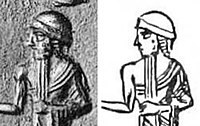
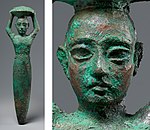


![Votive tablet of Shulgi, excavated in Susa: "For the goddess Ninhursag of Susa, his Lady, Shulgi, the great man, King of Ur, King of Sumer and Akkad, built her temple ". Louvre Museum, Sb 2884.[47]](http://upload.wikimedia.org/wikipedia/commons/thumb/5/55/Votive_tablet_of_Shulgi%2C_excavated_in_Susa%2C_SB_2880.jpg/150px-Votive_tablet_of_Shulgi%2C_excavated_in_Susa%2C_SB_2880.jpg)
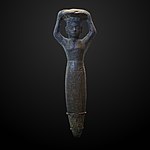
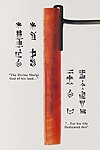
![Lugal Urimkima/ Lugal Kiengi Kiuri 𒈗𒋀𒀊𒆠𒈠𒈗𒆠𒂗𒄀𒆠𒌵, "King of Ur, King of Sumer and Akkad, on a votive tablet of Shulgi. The final ke4 𒆤 is the composite of -k (genitive case) and -e (ergative case).[53]](http://upload.wikimedia.org/wikipedia/commons/thumb/b/b9/Lugal_Urimkima_Lugal_Kiengi_Kiuri%2C_King_of_Ur%2C_King_of_Sumer_and_Akkad%2C_on_a_seal_of_Shulgi_%28transcription%29.jpg/150px-Lugal_Urimkima_Lugal_Kiengi_Kiuri%2C_King_of_Ur%2C_King_of_Sumer_and_Akkad%2C_on_a_seal_of_Shulgi_%28transcription%29.jpg)

![Earrings inscribed in the name of Shulgi.[54]](http://upload.wikimedia.org/wikipedia/commons/thumb/c/ce/Earrings_from_Shulgi.JPG/150px-Earrings_from_Shulgi.JPG)
![Seal of Shulgi, with Gilgamesh fighting a winged monster: "To Shulgi, son of the king, Ur-dumuzi the scribe, his servant".[55]](http://upload.wikimedia.org/wikipedia/commons/thumb/d/dc/Seal_of_Shulgi%2C_with_Gilgamesh_fighting_a_winged_monster.jpg/150px-Seal_of_Shulgi%2C_with_Gilgamesh_fighting_a_winged_monster.jpg)
![Seal of Shulgi, with worshipper and seated deity: "Shulgi, the mighty hero, King of Ur, king of the four regions, Ur-(Pasag?) the scribe, thy servant".[55]](http://upload.wikimedia.org/wikipedia/commons/thumb/f/fb/Seal_of_Shulgi%2C_with_worshipper_and_seated_deity.jpg/150px-Seal_of_Shulgi%2C_with_worshipper_and_seated_deity.jpg)

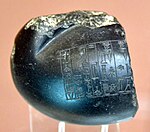
![A tablet from the period of Shulgi, mentioning the "Meluhha" village in Sumer. British Museum, BM 17751.[56] "Meluhha" (𒈨𒈛𒄩𒆠) actually appears on the beginning of the other side (column II, 1) in the sentence "The granary of the village of Meluhha".[57][56]](http://upload.wikimedia.org/wikipedia/commons/thumb/7/79/Meluhha_village_tablet_-_BM17751.jpg/107px-Meluhha_village_tablet_-_BM17751.jpg)














